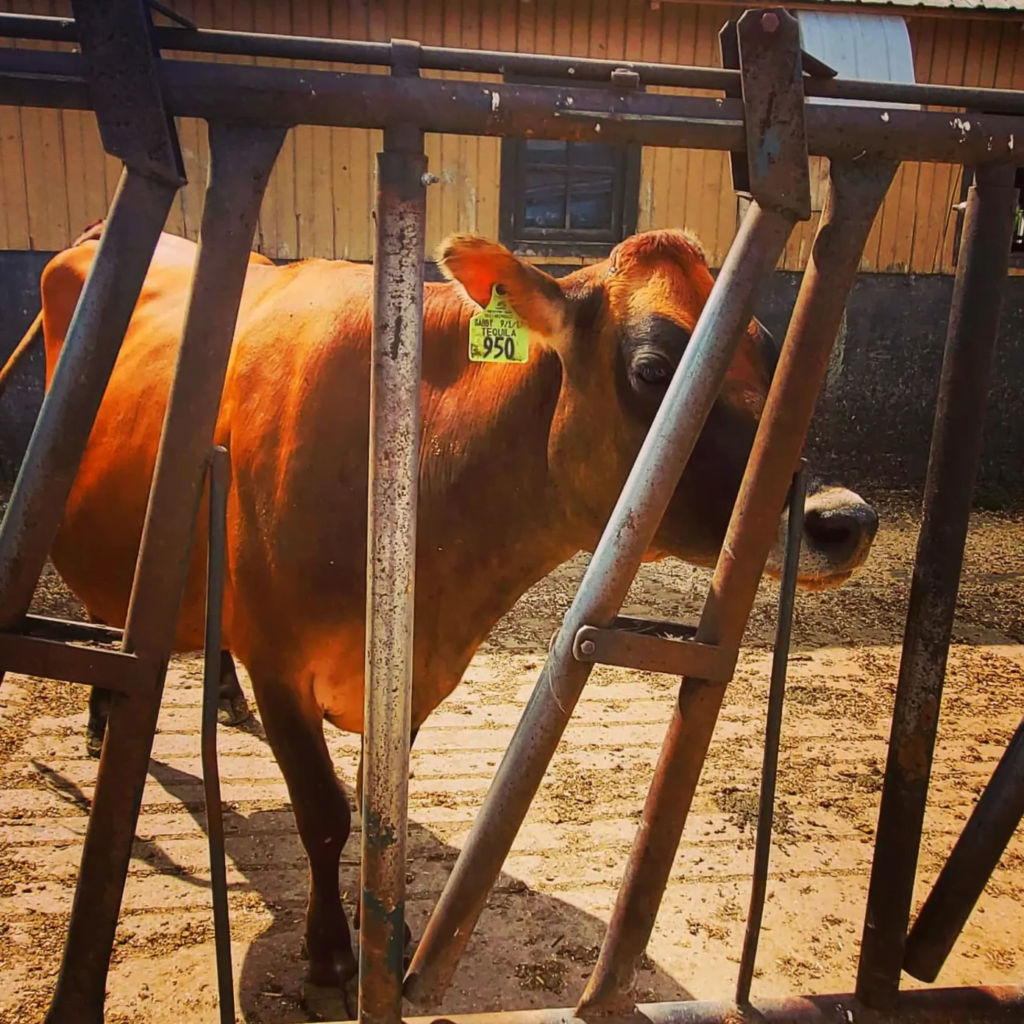
Twice a year I drive 100 miles to visit my favorite cow, Tequila, at Kilgus Farmstead in Livingston County, Illinois. Okay, actually I go to buy milk and beef. Being able to pet Tequila (and other cows) is a bonus.
When I got a job cooking in a Chicago restaurant, I was not surprised to spot Kilgus products in the walk-in fridge and freezer. The farm raises Jersey cows, which are a small breed, so their meat is fairly lean. And because of the way the cows are raised and because of what they’re fed, their meat is tasty and tender.
Kilgus is also a name many Chicagoans will recognize among milk brands at the supermarket; it was the milk gallon that gave me the idea to visit the farm. One day at Whole Foods, I picked up an $8 gallon of milk that touted it was bottled on a local family farm. I liked that concept. An inveterate budget grocery shopper, I wondered if I might be able to cut out the middleman and save money by picking it up myself. The label said it was from Central Illinois. Well, how far away could that be? I wondered.

I discovered that Kilgus was, as you now know, 100 miles away. So I made plans to drive there the next weekend. The country store at the top of a hill holds freezers and fridges full of milk and beef, plus Berkshire pork, and Boer goat, raised there and sold by the pound — all for less money than at my local grocery store. The farm store also carries products from other farms and artisans, including honey, flour, and cheese. There’s soap and tea and coffee and jam. I did most of my Christmas shopping here one year!

There’s usually a cheerful farm dog asking to be pet while you watch the cows grazing in the pasture near the barn. The farm uses rotational grazing to minimize the animals’ impact on the land. They have 17 grazing paddocks, and the cows are moved to a different pasture every day. One of the farmers told me that after they completed the new barn, none of the cows came outside in the morning like they usually did. It turns out the cows liked the new digs so much that they slept in! (This should be part of the animal-welfare rating system: Does your farmer let the cows sleep in?)
The farm was founded in 1958, and Duane Kilgus, one of the founders, gave me an ice cream (made with Kilgus milk, of course) and taught me some of the farm’s history on that first visit. The farm’s soft-serve ice cream machine features a different homemade seasonal flavor each week (think: pumpkin in the fall and mint chocolate in the winter). I started driving there once every other month; I even took orders from my friends and coworkers and hauled meat and milk home for them, too. The more I bought, the easier it was to justify the drive.

The thing is, if you want to buy a lot of meat at once, you need somewhere to put it — so I bought a cheap used chest freezer. I buy my meat by the quarter now (a quarter of a cow is one fourth of the meat from one animal), which lasts my family between six months to one year. I don’t get to pet cows as often, but I save more money.
Each quarter costs about $600, and it comes out to between 75 and 100 pounds of beef, which is a great per-pound savings on expensive cuts (here’s looking at you, $18-a-pound porterhouse). You pay the farm for the beef, and you pay the processor for the cutting. I can decide how thick I want my steaks and how many pounds of ground beef I want in each package. I bring a few coolers and pick up the frozen meat from the butcher.
In a typical quarter, half the meat is ground beef. I also get chuck roasts, sirloin tip roasts, stew meat, sirloins, ribeyes, and porterhouses. I get flank steak, brisket, short ribs, and bones. The butcher will save you the heart, tongue, and liver, too.

My favorite thing to make with the ground beef is the Bolognese sauce for my grandma’s lasagna. (She skipped ricotta in favor of wildly non-traditional melty Muenster.) The short ribs are fatty in a good way. I roast the bones to make stock. I also request some lard from processing, which I turn into tallow for making soap. Buying meat this way helps me think more creatively because I don’t want anything to go to waste.
I can customize my grocery order, and I get the best quality products at the most affordable price. I know where my food is coming from and how the animals are raised. Plus, if you’re eco-conscious, a dairy-lover, or a cow, it’s a great place to spend an afternoon.
This article was originally posted on Kitchn by Michele Metych. You can view the original article here.

